Art Videos on Principles of Design Variety Rhythm Emphasis and Unity
Unity in art is all virtually tying it all together; together is in fact the operative word here. Unity in fine art is nigh all the parts working to create a composition that speaks a m words or says nothing at all, either way, information technology is understood on a deeper level and its impression is felt. In this article, nosotros will hash out what is unity in art and provide diverse examples of unity in art and how it tin be applied.
Table of Contents
- i What Is Unity in Art?
- 1.1 The Importance of Harmony, Unity, and Variety in Art
- 2 Training Our Eyes: How to Use Unity in Art
- ii.1 Proximity
- two.2 Repetition
- 2.three Simplicity
- three Summary of Unity in Art
- iv Principles of Art – Farther Readings
- 5 Frequently Asked Questions
- 5.1 What Is Unity in Art?
- 5.2 How Is Unity in Fine art Used?
- 5.3 Why Is Unity in Art Of import?
- v.4 Is Unity in Art the Same equally Harmony in Art?
- 5.v What Are Examples of Unity in Art?
What Is Unity in Art?
Exploring the question around, "What is unity in art?" we need to briefly expect at how information technology is defined. If we look at the give-and-take "unity", it relates to a state of wholeness; it is described by some scholarly sources as "a totality of related parts: an entity that is a complex or systematic whole". We can apply this unity art definition for a clearer understanding when we look at unity as one of the Principles of art.
Therefore, if unity relates to wholeness, so unity in art will relate to the wholeness of an art composition, but what does this hateful exactly, and how practise nosotros achieve a "wholeness" in an fine art limerick?
 The Osculation (1907-1908) by Gustav Klimt, illustrating the use of unity in art through shape and form;Gustav Klimt, Public domain, via Wikimedia Eatables
The Osculation (1907-1908) by Gustav Klimt, illustrating the use of unity in art through shape and form;Gustav Klimt, Public domain, via Wikimedia Eatables
The wholeness of an fine art composition, whether information technology is a painting, drawing, or sculpture, is the adequate awarding and arrangement of all the principles of art and elements of art. These are considered the "edifice blocks" of a composition.
The principles of art extend into not only unity, but diversity, harmony, balance, emphasis, movement, rhythm, repetition/pattern, proportion, and calibration. Additionally, the elements of art include color, space, shape, texture, value, line, and form.
These might seem like a lot of parts needed to complete a composition; however, strategic use of the necessary elements and principles will yield desirable results and ultimately, a unified whole.
 Fruit Displayed on a Stand (c. 1881) by Gustave Caillebotte , illustrating the utilize of unity in art through shape and form;Gustave Caillebotte, Public domain, via Wikimedia Commons
Fruit Displayed on a Stand (c. 1881) by Gustave Caillebotte , illustrating the utilize of unity in art through shape and form;Gustave Caillebotte, Public domain, via Wikimedia Commons
The Importance of Harmony, Unity, and Variety in Fine art
Sometimes unity is used interchangeably with another principle of art called harmony. Although the two are very similar and are used interchangeably past some, it is besides important to notation that they are different. Let united states of america briefly look at what harmony in art refers to.
This is when the various art elements nosotros mentioned to a higher place are applied in a similar manner, or when "related" art elements are practical together, for example, similar color schemes, shapes or forms that complement one another similar circles and ovals, textures that are not too contrasting, and more.
Variety tin can be viewed equally the opposite of harmony because it creates more dissimilarity and therefore makes the composition more interesting and vibrant. If there is too much harmony, a composition can be "monotonous" or dull. And conversely, if in that location is too much diversity, it can brand the composition too busy, bright, or unbalanced.
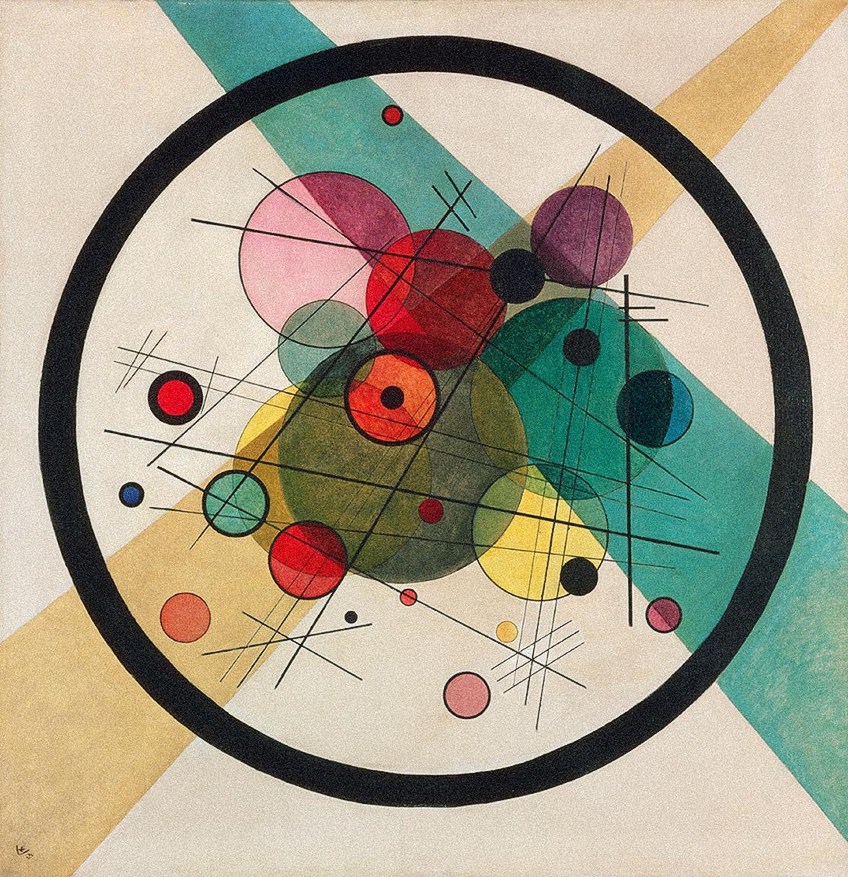 Circles in a Circle (1923) by Wassily Kandinsky, illustrating the use of unity in art through shape and class;Wassily Kandinsky, Public domain, via Wikimedia Eatables
Circles in a Circle (1923) by Wassily Kandinsky, illustrating the use of unity in art through shape and class;Wassily Kandinsky, Public domain, via Wikimedia Eatables
When harmony and diverseness work in unison in a composition there is a unifying effect of the whole, which relates to how unity in art works. Therefore, not only harmony merely unity and diversity in art are important principles to understand when creating or analyzing an artwork.
Therefore, it is important to think when researching and reading about unity and harmony in art that harmony tin can hateful something entirely unlike than unity.
Training Our Optics: How to Use Unity in Art
Unity is described by some art sources equally an "impression", and it is different to the other principles of fine art that are visually applied in artworks. Unity is more than of a concept; however, it can be measured by several criteria or applied equally a technique to ensure a visually whole artwork. With this, we tin railroad train our eyes to see the level of unity in art compositions.
 A Sunday Afternoon on the Island of La Grande Jatte (1886) by Georges Seurat, illustrating the employ of unity in art through shape and form; Georges Seurat, Public domain, via Wikimedia Eatables
A Sunday Afternoon on the Island of La Grande Jatte (1886) by Georges Seurat, illustrating the employ of unity in art through shape and form; Georges Seurat, Public domain, via Wikimedia Eatables
Proximity
Proximity in the unity in art relates to how close objects or figures are to one another in a limerick. Some objects can be positioned in patterns, or repetitions, while some are positioned very close to the other as a group.
Some objects or figures have more space betwixt them than others, which likewise affects the level of unity.
Whichever fashion objects or figures are placed in proximity to 1 another, this grouping enhances the sense of wholeness or unity of the limerick; some sources too state that even though there might be different "parts" placed together, this still enables our minds to view information technology as i or a "mass".
 Maestà (1308-1311) by Duccio di Buoninsegna; Duccio di Buoninsegna, Public domain, via Wikimedia Commons
Maestà (1308-1311) by Duccio di Buoninsegna; Duccio di Buoninsegna, Public domain, via Wikimedia Commons
Examples of unity in art include Duccio di Buoninsegna's Maestà (1308 to 1311), depicting groupings of angels and saints effectually the Madonna and the baby figure of Jesus Christ. When we look at this composition the proximity of the figures creates more unity of the whole, additionally, the proximity of the figures around the Madonna and Jesus Christ creates emphasis of the primal figures. Fernando Botero'sGuerrilla de Eliseo Velásquez (1988) is another instance of unity in art, where the composition is filled upward past various figures near one another, giving the impression of a unified group.
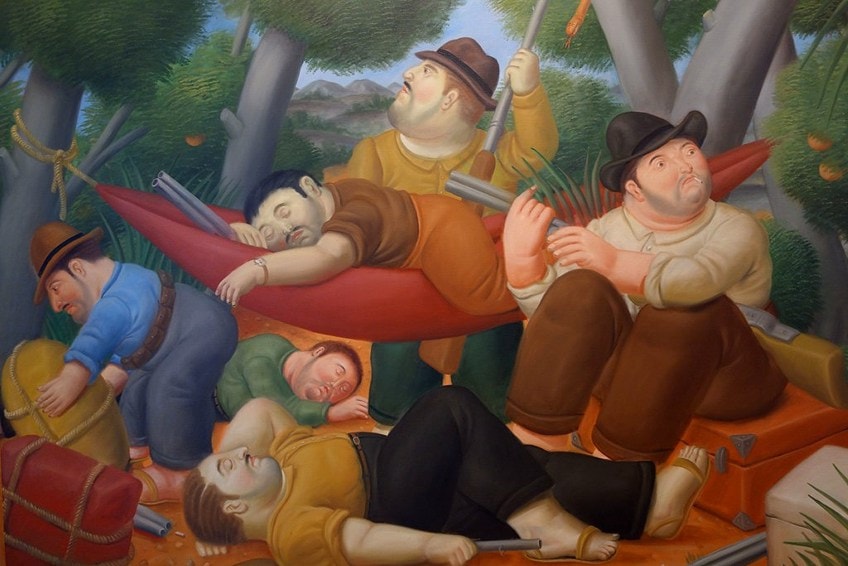 Guerrilla de Eliseo Velásquez (1988) past Fernando Botero, depicting guerrillas led by Eliseo Velásquez in the early on stages of "La Violencia", a 10 twelvemonth menstruation of violence/civil war that plagued Republic of colombia in the early 1950s; Fernando Botero, Public domain, via Wikimedia Commons
Guerrilla de Eliseo Velásquez (1988) past Fernando Botero, depicting guerrillas led by Eliseo Velásquez in the early on stages of "La Violencia", a 10 twelvemonth menstruation of violence/civil war that plagued Republic of colombia in the early 1950s; Fernando Botero, Public domain, via Wikimedia Commons
Repetition
Like proximity above, repetition consists of various patterns and sequences, exist they objects, figures, colors, shapes, textures, or any other art elements. Repetitions of patterns can too exist without any gaps in between them, which are referred to as tessellations. The awarding of these repetitions creates a unifying event within the overall composition.
Additionally, it can further emphasize the field of study matter and evoke emotion.
There are numerous examples of unity in art where repetition is applied, some include the Pop artist Andy Warhol and his famous Campbell's Soup Cans (1962) limerick. This composition copious images of Campbell's soup cans arranged adjacent to one another. Not only is the image repeated, just information technology also emphasizes the idea of commodities and mass product.
Another unity artwork example includes the Study of Regular Division of the Plane with Reptiles (1939) and the lithographs Reptiles (1943) by M.C. Escher. Here we come across repeated arrangements of reptiles, which all appear to be walking amongst one some other.
Other examples of unity in art include Gustav Klimt'south Tree of Life (1910-1911), Untitled (with blackness dot) (1988) by Damien Hirst, Shadow Play (1990) by Bridget Riley, Untitled (1969) by Anni Albers, and the installation titled Visitor at the Table by Katherina Fritsch (1988), amongst many others.
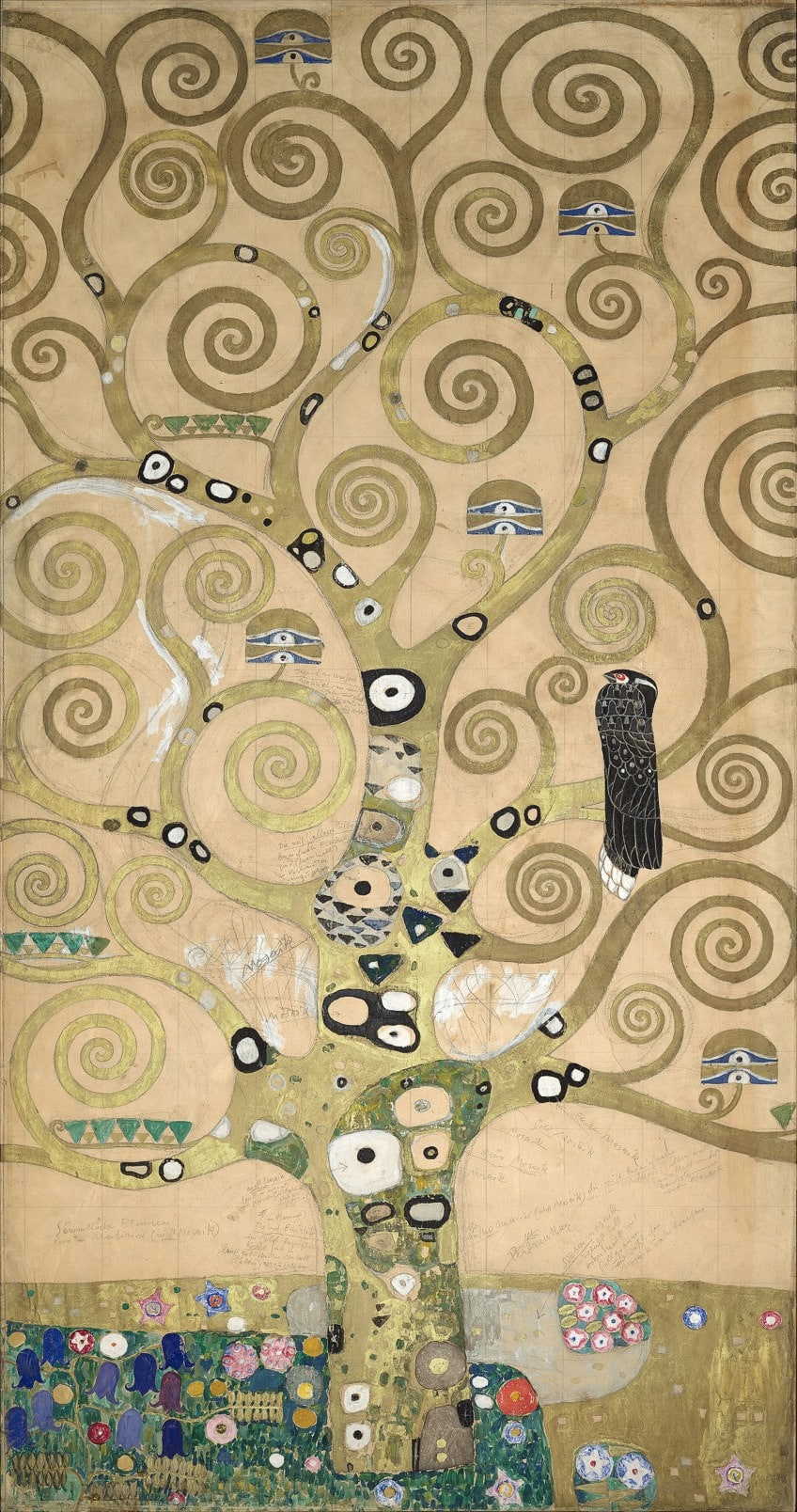 Tree of Life (1910-1911) by Gustav Klimt;Gustav Klimt, Public domain, via Wikimedia Commons
Tree of Life (1910-1911) by Gustav Klimt;Gustav Klimt, Public domain, via Wikimedia Commons
Simplicity
Simplicity refers to the exclusion and limitation of art elements like color, line, shapes, and so forth. When there is less colour, for example, a composition will be simpler compared to one that is filled with color; black and white or pencil sketches create simplicity in art, which tin be done through the hatching drawing technique.
Simplicity does non have to be relegated to only utilizing 1 fine art element; with the strategic placement of various art elements there tin still exist a simplification, which creates a unified whole.
For example, a composition, be it a painting or sculpture, can consist of shapes like circles or squares, arranged in a pattern, all in the same color or color scheme. With the patterned and repetitive nature through shapes, colour, lines, or others, it can appear simplified.
 Broadway Boogie Woogie (1942-1943) by Piet Mondrian, illustrating the apply of unity in art through simplicity;Piet Mondrian, Public domain, via Wikimedia Commons
Broadway Boogie Woogie (1942-1943) by Piet Mondrian, illustrating the apply of unity in art through simplicity;Piet Mondrian, Public domain, via Wikimedia Commons
This likewise correlates to the idea of minimalism and the "less is more" notion. Nosotros tin see this style from the Minimalist artists from the mid to late 1900s. Unity artwork examples include IKB 191 (1962) by Yves Klein, which consists of a purely monochromatic blueish paint on canvas. IKB stands for International Klein Blue, and it refers to Klein'southward custom combination of blue.
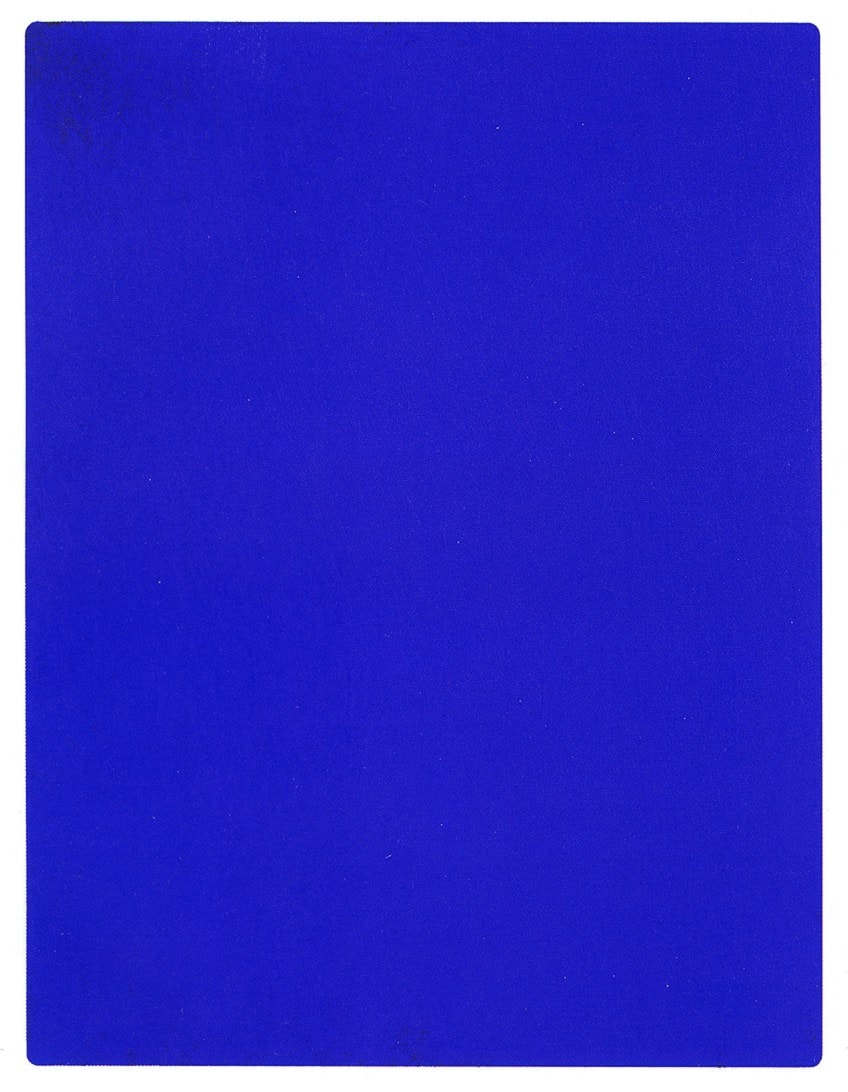 IKB 191 (1962) by Yves Klein;Yves Klein, Public domain, via Wikimedia Commons
IKB 191 (1962) by Yves Klein;Yves Klein, Public domain, via Wikimedia Commons
Other examples of unity in art that utilize the techniques of simplicity include Die Fahne Hoch! (1959) past Frank Stella. This is created from enamel paint on canvas, consisting of lines and black pigment. Stella's arrangement of color and line in a simplified yet patterned manner gives the composition a harmonious residual, which ultimately unifies all components.
Summary of Unity in Art
| Unity in Art Technique | Definition | Examples of Unity in Fine art |
| Proximity | Proximity refers to how shut figures or objects are placed to ane some other in an artwork composition. | Maestà (1308 to 1311) by Duccio di Buoninsegna The Musicians (1991) past Fernando Botero |
| Repetition | Refers to objects or figures, or art elements, that are repeated in patterns or sequences, this also includes tessellations. | Soup Cans (1962) past Andy Warhol Written report of Regular Partition of the Aeroplane with Reptiles (1939) by Grand.C. Escher Tree of Life (1910 to 1911) by Gustav Klimt Untitled (with black dot) (1988) by Damien Hirst |
| Simplicity | Refers to art elements and techniques that are excluded or limited in their utilization, some art elements or techniques may too merely exist used lonely or with others but in simplified ways. | IKB 191 (1962) by Yves Klein Die Fahne Hoch! (1959) past Frank Stella |
In the article above, we explored unity in art as one of the principles of fine art and how information technology tin be understood as a concept that refers to an creative composition as a unified whole of all the elements. We as well explored the unity art definition and how unity in art should non be confused with the other principle of art called harmony, still, the 2 terms are interchangeable.
The opposite of harmony is diverseness, and if both work together, it tin create a sense of unity in a composition.
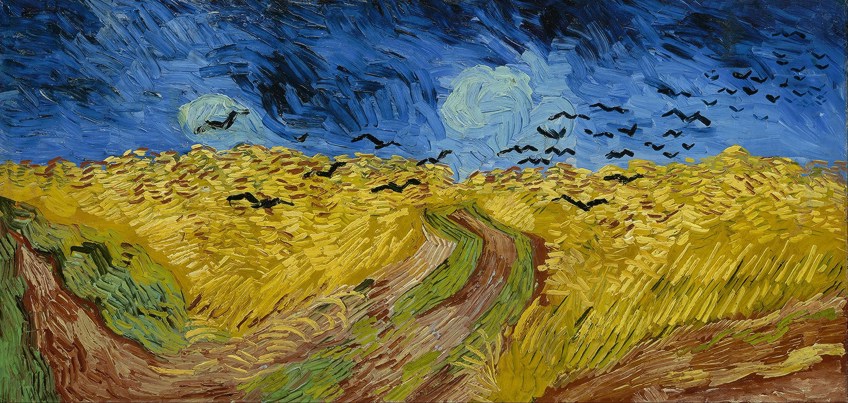 Wheatfield with crows (1890) by Vincent van Gogh, illustrating the use of unity in fine art through style, line, color, and texture;Vincent van Gogh, Public domain, via Wikimedia Commons
Wheatfield with crows (1890) by Vincent van Gogh, illustrating the use of unity in fine art through style, line, color, and texture;Vincent van Gogh, Public domain, via Wikimedia Commons
Unity in art can be applied through diverse techniques, nosotros named several to a higher place, for example, through proximity, repetition, and simplicity. Some of these techniques are closely linked to one another, for example, proximity tin can be achieved by repetition. All 3 can exist utilized in versatile ways coupled with the awarding of dissimilar fine art elements similar color, line, shapes, textures, and more.
Principles of Fine art – Further Readings
- Principles of Art main article
- Movement in Fine art
- Emphasis in Art
- Rhythm in Art
- Texture in Art
- Proportion in Art
- Rest in Art
- Harmony in Fine art
Unity in art is almost like the mucilage that binds a composition and all its elements together. Without a sense of all the parts, or "building blocks" working together to create what is referred to as a unified whole, the composition volition not accept the same effect or announced out of place, and then to say. Unity in art is an of import result that gives a lasting impression for all artworks, be they drawings, paintings, sculptures, installations, graphics, or any other medium.
Frequently Asked Questions
What Is Unity in Art?
Unity in art is i of the principles of fine art, otherwise too referred to as blueprint principles, which include balance, harmony, diverseness, calibration, proportion, repetition, emphasis, rhythm, and movement. These are utilized with the elements of art similar line, color, texture, shape, grade, value, and texture to create an artistic composition.
How Is Unity in Art Used?
Unity in fine art can be applied with different techniques; there are several mutual techniques that volition help reach unity in art, for example, repetition, proximity, and simplicity.
Why Is Unity in Art Important?
Unity in fine art is an of import art principle because it determines the and then-chosen wholeness or, as some state, the cohesiveness of the composition. It brings all the elements and other principles together and conveys the overall message or meaning of the artwork, without it the artwork volition appear confusing or out of balance.
Is Unity in Art the Same as Harmony in Art?
Unity in fine art has a different meaning to harmony in art, although some use both interchangeably. It is important to also understand the dissever meanings of these art principles. Unity refers to the wholeness of a composition, while harmony refers to art elements utilized in relation to one another, for instance, like shapes, similar colors, or other related art elements. Harmony in a composition contributes to the unity of all the parts.
What Are Examples of Unity in Art?
Examples of unity in art include placing objects or figures together or in groups, this tin can as well be done with art elements like lines, shapes, or colors. Other examples include repeating shapes or lines and arranging these in patterns or making tessellations. Unity can as well be achieved by simplified arrangements of art elements.
prendergastraters.blogspot.com
Source: https://artincontext.org/unity-in-art/
0 Response to "Art Videos on Principles of Design Variety Rhythm Emphasis and Unity"
Enviar um comentário